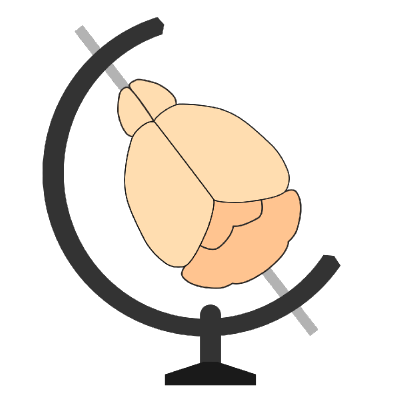Napari plugin#
How to use brainreg’s napari plugin.
Getting started#
To register your data, you will need a whole-brain image, i.e., not a part of a brain, and not some individual 2D sections.
The format doesn’t matter, as long as it can be loaded into napari.
The orientation, etc, is dealt with by brainreg.
Loading data#
Loading your data into napari will vary depending on the data type, but with most types, you should be able to drag and drop your data into the main napari window.
Note
If you are having trouble loading your data into napari, first check the napari hub to see if there’s a plugin to help. If that fails, go ahead and ask the nice people on the image.sc forum to see if anybody can help.
Starting the plugin#
Click Plugins at the top of the main napari window, and then click brainreg-register: Atlas registration.
A new docked widget will appear in your napari window.
Setting up registration#
Choose the napari image layer you wish to be registered from Image layer, along with the atlas you want to use from Atlas.
You must also set the voxel sizes in the axial (z) and in-plane (x, y) dimensions, along with the data orientation.
The orientation is defined by three letters, based on brainglobe-space, e.g. psl.
For more details on this, see the outline here.
Lastly, set an output directory (where you want to save the data).
Registering additional channels#
brainreg will use a single channel for registration.
This is typically an image without much signal, such as an image of only autofluroescence.
Images of brain-wide stains such as DAPI can also work well.
To register any additional channels, make sure these are selected in the list of layers on the left-hand side of the napari window.
The registration will be performed on the image chosen as Image layer, but the transformations will be applied to these other channels.
This is useful if you want to later analyse multiple channels, or if the channel of interest registers poorly due to high signal levels from staining, etc.
Caution
Make sure that the image layer you are registering is not selected in the list of napari image layers on the left-hand side, otherwise it will be registered twice!
Setting additional parameters#
There are many parameters that can be set to improve registration performance. For more details on these, see the documentation here.
Running brainreg#
You can then click Run, and the registration will start.
Lots of stuff will get printed to the console as brainreg runs, and when it’s done (it should only take a minute or so), you will see something like:
INFO - MainProcess cli.py:230 - Finished. Total time taken: 0:00:29.15
This means that the registration is complete, but you should see the results appear in the napari window.
Once the registration is complete, some new image layers will appear:
Atlas annotations - this the annotations image from the atlas (where each brain region has a unique value) warped to the data
Boundary image - this is a binary image, showing the boundaries between atlas regions.
These files are not the only ones created; they will all be saved in the output directory. These can be loaded into napari at any time, see the main visualisation page. For more details of the output files created, please see output files.
